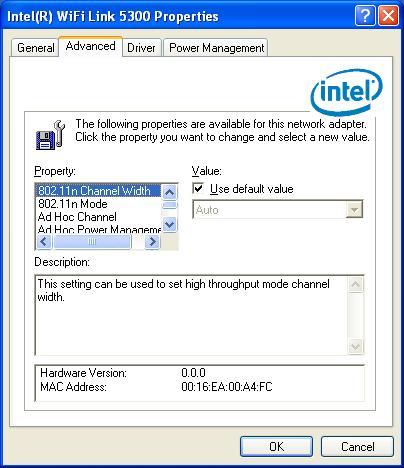

The Adapter Settings, advanced tab, displays the device properties for the WiFi adapter installed on your computer.
It may be one of the following network connection WiFi adapters:
For Windows XP* users, to see the WiFi adapter settings, on the Advanced Menu click Adapter Settings. Select the Advanced tab.
WiFi adapter Settings Description
Name |
Description |
|---|---|
802.11n Channel Width (2.4 GHz) |
Set high throughput channel width to maximize performance. Set the channel width to Auto or 20MHz. Auto is the default setting. Use 20MHz if 802.11n channels are restricted. NOTE: This setting is available only if the WiFi adapter is one of the following:
|
802.11n Channel Width (5.2 GHz) |
Set high throughput channel width to maximize performance. Set the channel width to Auto or 20MHz. Auto is the default setting. Use 20MHz if 802.11n channels are restricted. NOTE: This setting is available only if the WiFi adapter is one of the following:
|
802.11n Mode |
The 802.11n standard builds on previous 802.11 standards by adding multiple-input multiple-output (MIMO). MIMO increases data throughput to improve transfer rate. Select Enabled or Disabled to set the 802.11n mode of the WiFi adapter. Enabled is the default setting. An administrator can enable or disable support for high throughput mode to reduce power-consumption or conflicts with other bands or compatibility issues. NOTE: This setting is available only if the WiFi adapter is one of the following:
NOTE: To achieve transfer rates greater than 54 Mbps on 802.11n connections, WPA2-AES security must be selected. No security (None) can be selected to enable network setup and troubleshooting. |
Ad Hoc Channel |
Unless the other computers in the ad hoc network use a different channel from the default channel, there is no need to change the channel. Value: Select the permitted operating channel from the list.
NOTE: When an 802.11a channel is not displayed, initiating ad hoc networks is not supported for 802.11a channels. |
Ad Hoc Power Management |
Set power saving features for device to device (ad hoc) networks.
NOTE: This setting is only available if the WiFi adapter is one of the following:
|
Ad Hoc QoS Mode |
Quality of Service (QoS) control in ad hoc networks. QoS provides prioritization of traffic from the access point over a wireless LAN based on traffic classification. WMM (Wi-Fi Multimedia) is the QoS certification of the Wi-Fi Alliance (WFA). When WMM is enabled, the WiFi adapter uses WMM to support priority tagging and queuing capabilities for Wi-Fi networks.
NOTE: This setting is only available if the WiFi adapter is one of the following:
|
| Fat Channel Intolerant | This setting communicates to surrounding networks that this WiFi adapter is not tolerant of 40MHz channels in the 2.4GHz band. The default setting is for this to be turned off (disabled), so that the adapter does not send this notification. NOTE: This setting is available only if the WiFi adapter is one of the following:
NOTE: This setting is only available to the user and is not available for export in an administrator package. |
HD Mode |
In a WiFi network environment where several access points are nearby, this feature will reduce interference and improve your wireless connection. The default setting is for this to be turned off (disabled). NOTE: This setting is available only if the WiFi adapter is one of the following:
|
Mixed mode protection |
Use to avoid data collisions in a mixed 802.11b and 802.11g environment. Request to Send/Clear to Send (RTS/CTS) should be used in an environment where clients may not hear each other. CTS-to-self can be used to gain more throughput in an environment where clients are in close proximity and can hear each other. |
Lets you select a balance between power consumption and WiFi adapter performance. The WiFi adapter power settings slider sets a balance between the computer's power source and the battery.
NOTE: Power consumption savings vary based on Network (Infrastructure) settings. |
|
Preamble Mode |
Changes the preamble length setting received by the access point during an initial connection. Always use Auto Tx Preamble to provide optimal network throughput. Auto Tx Preamble allows automatic preamble detection. If supported, short preamble should be used. If not, use Long Tx Preamble. NOTE: This setting is only available if the adapter is an Intel(R) PRO/Wireless 2915ABG Network Connection or an Intel(R) PRO/Wireless 2200BG Network Connection. |
Roaming Aggressiveness |
This setting lets you define how aggressively your wireless client roams to improve connection to an access point.
|
Throughput Enhancement |
Changes the value of the Packet Burst Control.
|
Transmit Power |
Default Setting: Highest power setting. Lowest: Minimum Coverage.: Set the adapter to the lowest transmit power. Enables you to expand the number of coverage areas or confine a coverage area. Reduces the coverage area in high traffic areas to improve overall transmission quality and avoids congestion and interference with other devices. Highest: Maximum Coverage: Set the adapter to a maximum transmit power level. Select for maximum performance and range in environments with limited additional WiFi radio devices. NOTE: The optimal setting is for a user to always set the transmit power at the lowest possible level that is still compatible with the quality of their communication. This allows the maximum number of wireless devices to operate in dense areas and reduce interference with other devices that it shares the same radio spectrum with. NOTE: This setting takes effect when either Network (Infrastructure) or Device to Device (ad hoc) mode is used. |
Select which mode to use for connection to a wireless network:
NOTE: These wireless modes (Modulation type) determine the discovered access points displayed in the WiFi Networks list |
|
OK |
Saves settings and returns to the previous page. |
Cancel |
Closes and cancels any changes. |
To access the Windows XP* Advanced options: